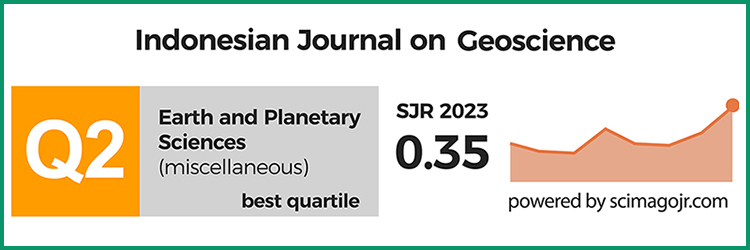Some Key Features and Possible Origin of the Metamorphic Rock-Hosted Gold Mineralization in Buru Island, Indonesia
DOI:
https://doi.org/10.17014/ijog.1.1.9-19Keywords:
gold mineralization, metamorphic rock, Buru Island, IndonesiaAbstract
This paper discusses characteristics of some key features of the primary Buru gold deposit as a tool for a better understanding of the deposit genesis. Currently, about 105,000 artisanal and small-scale gold miners (ASGM) are operating in two main localities, i.e. Gogorea and Gunung Botak by digging pits/shafts following gold-bearing quartz vein orientation. The gold extraction uses mercury (amalgamation) and cyanide processing. The field study identifies two types/generations of quartz veins namely (1) Early quartz veins which are segmented, sigmoidal, discontinous, and parallel to the foliation of host rock. The quartz vein is lack of sulfides, weak mineralized, crystalline, relatively clear, and maybe poor in gold, and (2) Quartz veins occurred within a ‘mineralized zone’ of about 100 m in width and ~1,000 m in length. The gold mineralization is strongly overprinted by an argillic alteration zone. The mineralization-alteration zone is probably parallel to the mica schist foliation and strongly controlled by N-S or NE-SW-trending structures. The gold-bearing quartz veins are characterized by banded texture particularly colloform following host rock foliation and sulphide banding, brecciated, and rare bladed-like texture. The alteration types consist of propylitic (chlorite, calcite, sericite), argillic, and carbonation represented by graphite banding and carbon flakes. The ore mineralization is characterized by pyrite, native gold, pyrrhotite, and arsenopyrite. Cinnabar, stibnite, chalcopyrite, galena, and sphalerite are rare or maybe absent. In general, sulphide minerals are rare (<3%). Fifteen rock samples were collected in Wamsaid area for geochemical assaying for Au, Ag, As, Sb, Hg, Cu, Pb, and Zn. Eleven of fifteen samples yielded more than 1.00 g/t Au, in which six of them are in excess of 3.00 g/t Au. It can be noted that all high-grade samples are originally or containing limonitic materials, that suggest the role of supergene enrichment. Interestingly, most of the high-grade samples contain also high grade As (up to 991ppm), Sb (up to 885 ppm), and Hg (up to 75 ppm). Fluid inclusions in both quartz vein types consist of four phases including L-rich, V-rich, L-V-rich, and L1-L2-V (CO2)-rich phases. Mineralizing hydrothermal fluid is typified by CO2-rich fluid, moderate temperature of 300 - 400 ºC and a typical low salinity (0.36 to 0.54 wt.% NaCl eq). Based on those key features, gold mineralization in Buru Island meets the characteristics of LS epithermal or orogenic gold deposit types; however, it tends to be fitter with orogenic gold deposit rather than another type.
References
Basuki, A., Sumanagara, D.A., and Sinambela, D., 1994. The Gunung Pongkor gold-silver deposit, West Java, Indonesia. Journal of Geochemical Exploration 50, p.371-391. doi:10.1016/0375-6742(94)90032-9
Carlile, J.C. and Mitchell, A.H.G., 1994. Mag¬matic arcs and associated gold and copper mineralisation in Indonesia: In: van Leeuwen, T.M., Hedenquist, J.W., James, L.P., and Dow, J.A.S. (eds.), Mineral Deposits of Indonesia, Discoveries of the Past 25 Years: Journal of Geochemical Exploration, 50, p.91-142.
Franklin, 2000. Prospeksi Mineral Logam di Kabupaten Buru Selatan, Provinsi Maluku, Kelompok Program Penelitian Mineral, Badan Geologi, www.bgl.esdm.go.id.
Gebre-Mariam, M., Groves, D.I., McNaughton, N.J., Mikucki, E.J., and Vearncombe, J.R., 1993. Archaean Au–Ag mineralization at Racetrack, near Kalgoorlie, Western Australia: A high crustal-level expression of the Archaean composite lode-gold system. Mineralium Deposita, 28, p.375-387. doi:10.1007/BF02431597
Gemmell, J.B., 2007. Hydrothermal alteration associated with the Gosowong epithermal Au-Ag deposit, Halmahera, Indonesia: Mineralogy, geochemistry and exploration implications. Economic Geology, 102, p.893-922. doi:10.2113/gsecongeo.102.5.893
Groves, D. I., Goldfarb, R. J., Gebre-Mariam, M., Hagemann, S. G., and Robert, F., 1998. Orogenic gold deposit: A proposed classification in the context or their crustal distribution and relationship to other gold deposit types. Ore Geology Review, 13, p.7-27. doi:10.1016/S0169-1368(97)00012-7
Groves, D. I., Goldfarb, R. J., and Robert, F., 2003. Gold deposit in metamorphic belts: Overview or current understanding, outstanding problems, future research, and exploration significance. Economic Geology, 98, p.1-29.
Guntoro, A., 2000. Structural, sedimentary and tectonic evolution of the Buru Island, Central Mollucca, Indonesia-In relation to the hydrocarbon prospect. AAPG International Conference and Exhibition, Abstract.
Hagemann, S.G., Gebre-Mariam, M., and Groves, D.L., 1994. Surface-water influx in shallow-level Archean lode-gold deposits in Western Australia. Geology, 22, p.1067- 1070. doi:10.1130/0091-7613(1994)022<1067:SWIISL>2.3.CO;2
Hagemann, S.G., Groves, D.I., Ridley, J.R., and Vearncome, J.R., 1992. The Archaean lode-gold deposits at Wiluna, Western Australia. High level brittle-style mineralisation in a strike-slip regime. Economic Geology, 87, p.1022-1053. doi:10.2113/gsecongeo.87.4.1022
Idrus, A., Kolb, J., and Meyer, F.M., 2007. Chemical composition of rockforming minerals in copper-gold-bearing tonalite porphyry intrusions at the Batu Hijau deposit, Sumbawa Island, Indonesia: Implications for crystallisation conditions and fluorine-chlorine fugacity, Special Issue. Resource Geology, 57 (2), p.102-113. DOI:10.1111/j.1751-3928.2007.00010.x
Idrus, A. and Prihatmoko, S., 2011. The metamorphic rock-hosted gold mineralization at Bombana, Southeast Sulawesi: A new exploration target in Indonesia, Proceedings of The Sulawesi Mineral Seminar, Manado 28-29 November 2011, p. 243-258.
Meldrum, S.J., Aquino, R.S., Gonzales, R.I., Burke, R.J., Suyadi, A., Irianto, B., and Clarke, D.S., 1994. The Batu Hijau porphyry copper-gold deposit, Sumbawa Island, Indonesia. Journal of Geochemical Exploration, 50, p.203-220. doi:10.1016/0375-6742(94)90025-6
Mertig H.J., Rubin, J.N., and Kyle, J.R., 1994. Skarn Cu-Au ore bodies of the Gunung Bijih (Erstberg) district, Irian Jaya, Indonesia. Journal of Geochemical Exploration, 50, p.179-202. doi:10.1016/0375-6742(94)90024-8
Querubin, C.D., and Walters, S., 2011. Geology and Mineralization of Awak Mas: A Sedimentary Hosted Gold Deposit, South Sulawesi, Indonesia. Proceedings of The Sulawesi Mineral Seminar, Manado 28-29 November 2011, p. 211-229.
Tjokrosapoetra, S., Budhitrisna, T., and Rusmana, E., 1993. Geological Map of Buru Quadrangle, scale 1:250.000. Geological Research and Development Centre, Bandung.
Wajdi, M.F., Santoso, S.T.J., Kusumanto, D., and Digdowirogo, S., 2011. Metamorphic Hosted Low Sulphidation Epithermal Gold System at Poboya, Central Sulawesi: A General Descriptive Review, Proceedings of The Sulawesi Mineral Seminar, Manado 28-29 November 2011, p. 201-210.
Yardley, B. W. D., 1989. An introduction to metamorphic petrology. Longman Scientific & Technical, Essex, 247pp.



















